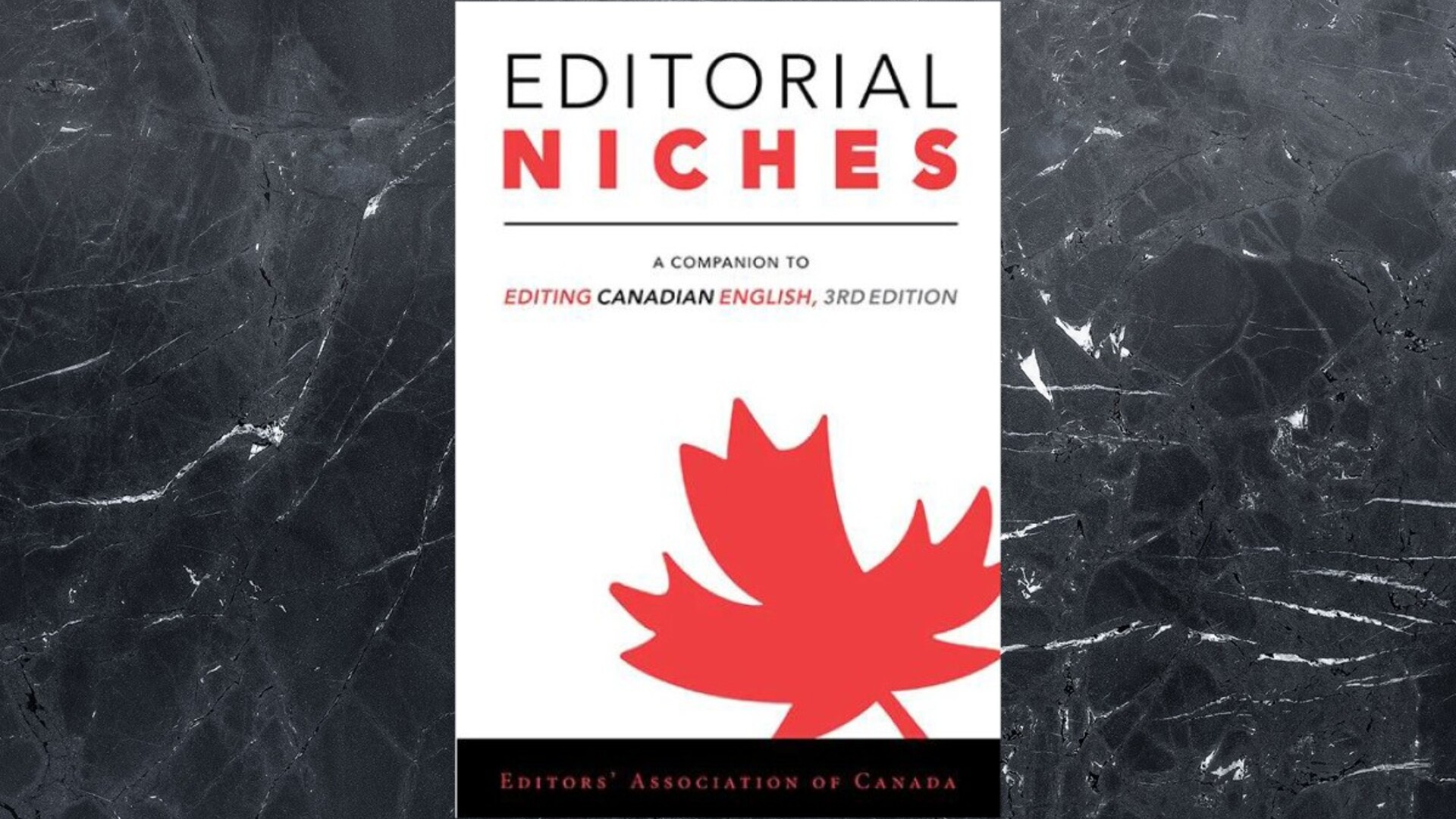
The Editing Company
Toronto, Ontario
RECENT POSTS
TEC Blog
Categories
Show All- Editing
- Grammar
- Usage
- Style
- Editor/writer
- Publishing
- Business
- Writing
- Writers support group
- Event
- Proofreading
- Copyright and permissions
- Usage
- Book reviews
- Editing new media
- Technology
- Books & libraries
- Ttc stories
- Editing & marketing
- Office happenings
- Social media & community
- Language & editing
- Social media
- Editing & marketing
- Indexing
- Book design
- Tec clients
- Guest blogger
- Creative women doing sixty
- Book clubs
- Books and reading
- Ebook technology & services
- Editing numbers
- Editing & technologies
- Opera, movies

Find Your Forte with Editorial Niches
by Samantha Rohrig
Published at 2021-04-07
niche /niːʃ/
noun
1. a shallow recess, esp. in a wall to contain a statue etc.
2. a comfortable or suitable position in life or employment.
3. a specialized but profitable corner of the market: [also attributive]: niche marketing.
4. (Ecology) a position or role taken by a kind of organism within its community.
To be honest, I had no idea what to expect when Beth first slid this slim volume across my desk last month. Editorial niches? Like the sort of specialist editing required by pharmaceutical companies or for especially technical “how-to” manuals? All those specialized branches of editing that tend to get mentioned only once (and in passing) in your typical “Intro to Publishing” course because there is just so much else that needs to be covered?
Well, yes, in part. But this handy little book is a lot more than just a peek into the lesser-known nooks and crannies of the world of editing.
A Companion Piece
Editorial Niches is in fact the companion volume to Editing Canadian English, 3rd edition (ECE3) — the style manual of Editors Canada and one of three resources I first purchased for myself after deciding that I wanted to seriously pursue a career in editing (the others being Einsohn and Schwartz’s The Copyeditor’s Handbook, and Maxine Ruvinsky’s Practical Grammar).
In case you are unfamiliar with Editorial Niches’ parent book, ECE3 describes itself as presenting “a flexible but systematic approach to creating workable Canadian styles,” the goal being not to impose a uniform style, but “to help editors make informed and appropriate choices for each project” (ECE3, p. xiii). The content of what would become Editorial Niches was originally planned as the final two chapters of ECE3 (chapters 12 and 13), but for reasons of length and cost these sections ended up being published separately.
One result of this choice is that while ECE3 remains an invaluable resource for a relatively wide audience — editors, of course, but also writers, translators, students, instructors, and more — Editorial Niches is a more specialized resource primarily geared towards an audience of editors alone (and, I would argue, new or would be editors, such as myself, in particular).
What Is Editing?
Establishing its link to ECE3 by continuing with the same chapter numbering, Editorial Niches begins with an exploration of the key roles and requirements, broadly speaking, of editors today (chapter 12). It starts with a simple question — “What is editing?” — which it answers in the pages that follow by outlining the knowledge and practices that define professional editors, and the standards to which professional editors should be held.
It introduces readers to the Professional Editorial Standards (PES) first established by Editors Canada in 2009 for structural editing, stylistic editing, copy editing, and proofreading (the latest version of PES is also available online here), and then provides a helpful overview of the sort of professional development opportunities available to editors in Canada, including online editing courses, annual conferences, mentorship opportunities, and the benefits of Editors Canada’s own certification program.
The rest of chapter 12 surveys two other important editorial roles — fact checking and indexing — and concludes with two short sections on email etiquette and editing software. I will admit that here I did wonder again (briefly) just what this book was all about — yes, editors require both reliable editing software and good email etiquette to succeed at their jobs but, beyond that, how are these topics related to one another or to the idea of editorial niches in general? One does in a few places such as this get the sense that this volume is a bit of a hodgepodge collection of all those things the editors wanted to include in ECE3 but for which they couldn’t find quite the right place.
As a desktop handbook, however, with a clear and easy-to-navigate table of contents, Editorial Niches’ assortment of sometimes loosely connected topics really won’t impact its overall utility or usefulness as a resource for editors (i.e., like any good handbook, its value lies in being able to pick it up and easily find what you might need at any given moment).
And, of course, the advice given in these sections is sound and will prove especially valuable for those new to the profession. I, for one, am eager to check out both the EndNote and NoteStripper plug-ins recommended for editors who work extensively with citations and bibliographies!
Cookbooks, and Comic Books, and Plays. Oh, My!
The remaining two-thirds of the book (chapter 13) pick up the volume’s title in earnest and delve into the wide range of editorial niches one might encounter or wish to pursue in the course of their career. The chapter covers more familiar areas of focus, including both trade books and educational materials, as well as several decidedly more “niche” areas, including editing for cookbooks, comic books, collections of poetry, screenplays, government documents (for which you may need to get official security clearance), and research proposals.
There is a lot to learn and take away from this chapter — way more than I could ever hope to cover here — but one of the things I found most interesting was the section on editing online materials (websites, blogs, and even social media posts). As the book describes it, the Internet is still very much the Wild West of the editing world: anyone can publish anything at any time and there are no style guides or any dedicated group of professionals to ensure quality and consistency (p. 68). In recent years, however, readers have started to expect (nay, demand!) a higher standard of quality for the online content they consume, which means that this is an area ripe with potential for editors looking to carve out a niche (!) for themselves.
The section on online materials thus provides helpful advice for working with site designers and introduces editors to the concept of “scanability” and several other good principles of website design, including the importance of using plain language and how to employ keywords and links for search engine optimization.
One other thing I found particularly useful in chapter 13 was the short bit of advice about working with first-time authors (pp. 101–2), namely, that it is important to always keep in mind that most first-time authors will be unfamiliar with the specific technical language editors use. It was not that long ago that I myself unknowingly used “copy editing” and “proofreading” interchangeably, and I had never even heard of substantive editing before!
Most first-time authors, whatever their medium, will be the same way — many even believing that “editing” is nothing more than “catching typos.” Freelance editors in particular will often have to clarify just what is meant when a first-time client presents them with a book manuscript or a play or a business report and says, “All it needs is a final once-over.”
As the contributors of Editorial Niches remind us editors — new and seasoned alike — providing a crash course in “Editing and Publishing 101” to first-time authors and clients to ensure everyone is on the same page at the start of a project is never a bad idea.
The Last Word
As someone just starting out in the field, I really can’t speak to the book’s usefulness for seasoned editors with years of professional experience already under their belts — though I suspect that it would serve as a handy guide for anyone who might be considering expanding their repertoire of services or thinking about trying out a new area of editing.
For myself, however, and for anyone else taking their first steps into the world of editing (or even just considering taking those first steps), Editorial Niches is an invaluable guidebook on the various avenues and opportunities editors might wish to pursue. Especially if you are thinking about working as a freelance editor or launching your own small editing business, this book is an excellent place to start, providing not only insight to the various editorial niches in which one might wish to specialize, but also offering advice on how to begin carving out a niche for yourself within the wider world of professional editing.
Editorial Niches is available in print from UBC Press, Chapters Indigo, and many independent Canadian booksellers. The Editing Canadian English eBook also happily reunites Editorial Niches with its parent book, ECE3, in a single volume.




